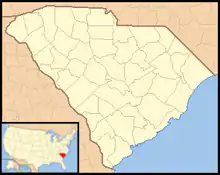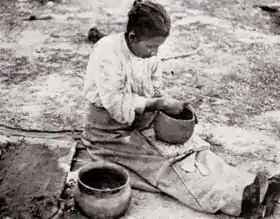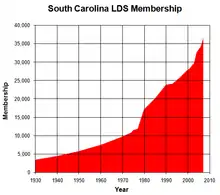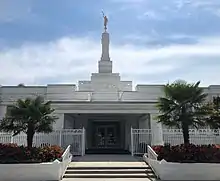The Church of Jesus Christ of Latter-day Saints in South Carolina
As of December 31, 2017, The Church of Jesus Christ of Latter-day Saints reported 40,608 members in six stakes,[1] 69 congregations (56 wards and 13 branches) one mission, and one temple in South Carolina.[2]

History
The first LDS member in South Carolina is believed to be Emmanual Masters Murphy, who was baptized in Tennessee in 1836. When Elder Lysander M. Davis arrived in South Carolina in 1839 (nine years after the Church was organized in New York), he found the Murphys had people prepared for baptism. Seven of these were baptized.[3]
Opposition arose and Davis was briefly jailed. Murphy had reportedly spoken with Church President Joseph Smith in the late 1830s, and was told to warn South Carolinians of the destruction soon to hit their state, "the wars that will shortly come to pass, beginning at the rebellion of South Carolina, which will eventually terminate in the death and misery of many souls ... the Southern states will call on other nations, even the nation of Great Britain..." This warning saw reality in 1861, when the Confederates attacked Fort Sumter, and the Civil War commenced.[3][4][5]
Catawba tribe

The South Carolina Conference was organized on March 31, 1882, with its first president as Elder Willard C. Burton of the Southern States Mission. (Southern States Mission History 1832–1880) The Kings Mountain Baptist Church had several families converted on March 12, 1882. Some of the earliest branches were established at King's Mountains beginning March 3, 1882, and among the Catawba Indian community beginning July 31, 1885. Conference headquarters were established at the plantation of John Shaw Black, a man who remained unbaptized to provide refuge for the Church, and a veteran of the Palmetto Sharpshooters. Many converts, including Indians, moved onto his plantation to escape persecution. The Catawbas also shielded missionaries from persecutions. Two families were noted in Missionary journals as being home base, James and Elizabeth W Patterson's home protected them on the occasions of the mobs hunting them. Evan and Lucy Marsh Watts were the host family when Elder C E Robinson died, and they were again helping when the two Elders were injured, Elder W C Cragun and F A Franughton. Most of the Catawbas joined the Church and remained faithful in South Carolina.[6]
One of the more known LDS members of the Catawba tribe was Samuel Taylor Blue (Chief Blue). Blue was baptized in 1897. A few years later he served as branch president of the branch of the LDS Church on the Catawba Reservation. In the early 20th century he would often help missionaries escape mobs.[7] In 1950 Blue traveled to Salt Lake City and gave a talk at General Conference on April 9.[8]
Another Catawba, the first Lamanite Patriarch, William F Canty came from 5 families who moved west with the Migration in 1887. His father John Alonzo Canty was the first Branch President of the Gaffney area, and James Patterson, his grandfather was the first Branch President of the Catawba Branch. William (Buck) Canty spoke at the BYU Indian school graduation many times in the 1970s and toured with the Lamanite Generation in 1978.
Genealogy of the Western Catawba, Missionary Journals of Joseph P Willey and Pinkney Head, and My Father's people, all written by Judy Canty Martin. News articles from the Church news in 1978 and other sources of family.
Church growth
Progress and persecution continued in the 1890s. Mobs often gathered to persecuted missionaries. In 1897, mobs burned one of South Carolina's first Latter-day Saint meetinghouses in ab area called by locals Centerville near the small town of Ridgeway South Carolina. It was rebuilt and burned again in 1899.[9]
Branches organized included Society Hill, Columbia, Charleston, and Fairfield. However, as converts migrated to the West, branches dwindled, and some were reorganized later with new converts. The South Carolina conference included six branches (four with meetinghouses) and 10 Sunday Schools.[9]
On November 20–21, 2004, President Hinckley spoke to nearly 12,000 Church members in Columbia, S.C., with proceedings carried to 11 meetinghouses in 11 other stakes in South Carolina and Georgia.[10]
In 2020, the LDS Church canceled services and other public gatherings indefinitely in response to the coronavirus pandemic.[11]
Humanitarian efforts
LDS Church in South Carolina have been involved in a number of humanitarian services. Some of these include disaster relief, aid to the needy and sick, along with other services. Some of the more significant relief given by the church or its members in South Carolina are mentioned in this section.
The Church has provided relief to many natural disasters including: Hurricane Hugo,[12][13] Hurricane Andrew,[14] flooding from Tropical Storm Alberto in Georgia,[15] Hurricane Opal,[16] and Florida's Hurricane Jeanne.[17]
Following Hurricane Katrina in 2005, several thousand Latter-day Saint volunteers from South Carolina and other areas, went to Louisiana and Mississippi. Many of them taking time out of their jobs or came down on the weekends to help anyone needing assistance.[18]
In 1996, the LDS Church authorized $100,000 and service to help rebuild 28 of the predominantly black churches across the South (including in South Carolina) that burned in the previous 18 months. These funds were divided according to need.[19]
In 1996, the LDS Church donated 41,000 pounds of food to the Crisis Ministries Center in the Charleston area.[20]

Membership history
| Year | LDS Membership |
|---|---|
| 1900 | 1,200 |
| 1930 | 3,343 |
| 1974 | 10,755 |
| 1980 | 17,012 |
| 1990 | 23,731 |
| 1999 | 27,399 |
| 2007 | 36,141 |
Stakes
South Carolina's first stake was created in Columbia on October 19, 1947. It included the entire state with wards in Columbia, Greenville, Charleston, Gaffney, Hartsville, Ridgeway, and Spartanburg. Its branches included Augusta (Georgia), Sumter, Society Hill, Winnsboro, and Darlington.
The South Carolina West Stake (Later known as Greenville South Carolina East Stake), was organized 1963. In 1968, the South Carolina East Stake was organized which later became known as the Florence South Carolina Stake. The Charleston Stake was then organized in 1972.
| Stake | Organized |
|---|---|
| Charleston South Carolina | August 20, 1972 |
| Columbia South Carolina | October 19, 1947 |
| Florence South Carolina | February 5, 1978 |
| Fort Mill South Carolina | August 26, 2018 |
| Greenville South Carolina | November 19, 1972 |
| Greenville South Carolina East | November 16, 2003 |
| West Columbia South Carolina | February 3, 2002 |
- Charleston South Carolina Stake - Originally named Charleston Stake when organized in 1972.
- Columbia South Carolina Stake - Originally named South Carolina Stake (S.C., Georgia)
- Florence South Carolina Stake - Originally named South Carolina East (South Carolina) when it was organized on April 21, 1968. The name was then changed to the Columbia South Carolina East Stake. It was finally reorganized and named the Florence South Carolina on February 5, 1978.
- Fort Mill South Carolina - Stake was created from congregations in the Charlotte North Carolina South and Gastonia North Carolina Stakes. Was created by Elder Vern P. Stanfill, General Authority Seventy, and Elder Matthew S. Harding, an Area Seventy in August 2018. First stake President being Blake D. Smith. Stake formed on August 26, 2018. This stake is served by the North Carolina Charlotte Mission.
- Greenville South Carolina - Originally named Greenville Stake when it was organized in 1972.
- Greenville South Carolina East - Originally named South Carolina West (S.C, N.C.) when it was organized on January 37, 1963. It was then reorganized and named the Greenville South Carolina East Stake on November 16, 2003.
Missions
South Carolina was originally part Southern States Mission when it was opened in 1876. In June 1971, the Southern States mission was divided and renamed the Georgia-South Carolina Mission. On June 20, 1974, it was renamed the Georgia Atlanta Mission in accordance to the new church naming policy for missions. On July 1, 1975, the South Carolina Columbia Mission was organized.
Temples
On 16 October 1999 the Columbia South Carolina Temple was dedicated by President Gordon B. Hinckley.
|
|
62. Columbia South Carolina Temple | ||
|
Location: |
Hopkins, South Carolina, United States | ||
See also
References
- South Carolina Stakes.LDS Stake & Ward Web Sites
- Jenson, Andrew. Encyclopedic History of the Church of Jesus Christ of Latter-day Saints. Deseret News Publishing Company
- Prophecy preceeded [sic] conflict by 28 years.Deseret Church News.Saturday, June 19, 1993
- City of prophecy. Church News, February 19, 2005.
- LaMar C. Berret, History of the Southern States Mission 1831-1861, thesis 1960.
- Tate, Lucille C., LeGrande Richards: Beloved Apostle (Salt Lake City: Bookcraft, 1982) p. 169
- Encyclopedia of Latter-day Saint History, p. 1165
- Deseret Morning News.2008 Church Almanac.
- Hospitable South welcomes Church leader. Church News, November 27, 2004
- Lovett, Ian. "Mormon Church Cancels Services World-Wide Amid Coronavirus Crisis", The Wall Street Journal, 12 March 2020. Retrieved on 31 March 2020.
- Fury of Hurricane Hugo unites LDS in midst of overwhelming ruin. Church News, September 30, 1989
- After the storm's fury: members rally to offer comfort and support. Church News, November 11, 1989
- Members provide outpouring of help. Church News, September 12, 1992
- 6,000 ease aftermath of flooding. Church News, July 30, 1994
- LDS render service in wake of Opal's rage. Church News, October 14, 1995
- Hurricane Jeanne adds to members' storm misery. Church News, October 2, 2004
- Helping rebuild burned chapels. Church News, November 9, 1996
- Rescue program given food. Church News, November 16, 1996
Further reading
- Hawes, Jennifer Berry (September 30, 2012), "Leap of faith: Skeptics aside, Mormonism is on the rise", The Post and Courier, Charleston, SC, retrieved 2012-10-30.
External links
- Newsroom (South Carolina)
- ComeUntoChrist.org Latter-day Saints Visitor site
- The Church of Jesus Christ of Latter-day Saints Official site
- Those who went before Church News (July 20, 1991)
